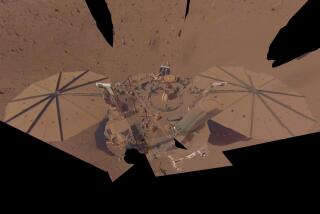NASA: Mars Curiosity rover finds rocky signs of once-gushing stream
NASAâs Curiosity rover has found evidence of strong streams that once gushed across the Martian surface, mission scientists said Thursday.
Curiosity landed in Gale Crater on Aug. 5. But now, less than a couple of months into the Mars Science Laboratoryâs two-year mission, the Red Planet rover used its Mast Camera to examine rocks on its way to Glenelg Intrigue. Glenelg has caught scientistsâ eyes because the odd spot serves as a junction between three different types of terrain.
The two outcrops in between, named Link and Hottah, have provided some exciting results in the meantime. The missionâs head scientist, Caltech geologist John Grotzinger, described the outcrop at Hottah as a raised cement section in a âjackhammered urban sidewalk,â possibly caused by an impact on the surface.
The telltale rocks are made of sandy rock riddled with large pebbles. The shape of those pebbles tells the scientists that the rocks must have traveled a long way, bumping into each other and smoothing out the rough edges. The relatively large size of many of those stones â some the size of a golf ball â tells them that water, not wind, must have carried them.
Such rocks could have traveled 20 to 25 miles and started out rough and blocky, big as a football, before being ground down to their current size, the scientists said.
âThis is a rock that was formed in the presence of water, and we can characterize that water as being a vigorous flow,â Grotzinger said.
Currently, Curiosity is located about two to four miles from an alluvial fan â a triangle-shaped network of channels on a slope that indicates water may have pushed material downward, spreading as it flowed.
Geologists can tell much about a rockâs history and how it formed by looking at the grain size, shape, arrangement and color in a given rock, said co-investigator Rebecca Williams of the Planetary Science Institute in Tucson. And all of that can be captured with a few high-resolution images.
âIn some cases when you do geology, a pictureâs worth a thousand words,â Grotzinger said.
The scientists canât say for sure when the water was last flowing, said science co-investigator William Dietrich, a UC Berkeley geologist, who wagered it was more than a millennium ago.
The scientists are looking for âhabitable environments.â Places on Mars that contain the basic ingredients to support life: water, an energy source and organic molecules that serve as the building blocks for all living things. Now, the discovery of water âleads us to the beginning of the science mission,â Grotzinger said, âwhere ⌠we may now begin to characterize habitable environments.â
But the rover has not analyzed the rocks at these outcrops on a chemical or mineralogical level â itâs set to move on toward Glenelg. Curiosityâs ultimate destination is Mt. Sharp, a three-mile-high mound in the middle of Gale Crater, where clays may hold clues about whether Mars was ever hospitable to microbial life.
Follow me on Twitter @aminawrite






